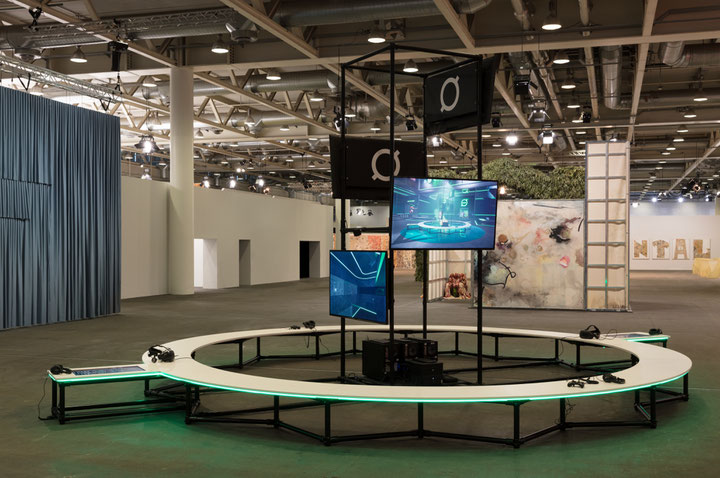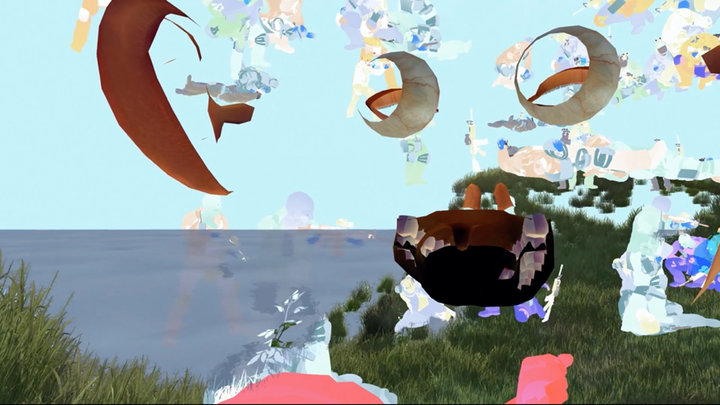In recent years video games have made their way into the field of art as a medium. Exhibitions at MoMA New York (2012) and the Barbican Center in London (2019)1 started to investigate this phenomenon. Meanwhile, a young generation of artists use video games in their work both as a visual influence on established media, such as painting or installation, as well as to produce independent video game art.
In 2019, Art Basel Unlimited presented Lawrence Lek’s multimedia work Nøtel. The installation consisted of a metal frame on which four screens were attached. A circular bench was placed around this arrangement for the viewers to sit down and interact with a game and a virtual reality tour. Surrounded by world-famous stars, the work of the young artist stood out through the use of an equally young medium—video games.2
The playable part of the installation allows the viewer to enter a virtual, openly accessible world and explore it as they please. Nøtel is the name of a fictional hotel that promises its upscale guests security and privacy through its fully technological operation and the absence of human staff. Lek includes spaces from his own environment in his works, which makes the game and the terrain appear more realistic, but also—due to the absence of other people—more dystopian. In the first-person perspective, the player wanders through the futuristic architecture, whereby aspects such as alienation and belonging come to the fore. The voice of an artificial intelligence accompanies the game and explains the environment and the concept of the hotel. In addition, the soundtrack produced by Goodman underlines the futuristic-surreal mood of the game.
Video game art can be seen as the opposite of “interpassive” art consumption. By actively contributing to the completion of the game as a work of art, the players become collaborators and the interaction with art is expanded to include the motor component of playing. According to Robert Pfaller and Slavoj Žižek, the term “interpassive” in connection with art questions the delegation of enjoying artistic production.3 Direct interaction with the game overcomes the barrier of the “interpassive” and positions the viewer as collaborators with the artist in relation to his video game. It is only through the interaction of the viewer with the mechanics of the game that its full scope is extracted.
Although the actual freedom of the players in the virtual space of the game is limited, their performative interaction with the game as an installation is already sufficient to view this interaction as communal.
This use of the video game as a collaborative work of art can also be explained in terms of the theory of relational aesthetics. Nicolas Bourriaud defines it as an artistic practice that uses all human interactions and their social contexts as a theoretical starting point instead of an independent private space.4 Through their interaction, the players can generate a performative exchange with the other viewers. While one person is playing, bystanders can intervene in the course of the game by communicating with the players. These different roles that the video game generates as a work of art depend on the relationships between the viewers and the location of the game. The areas of tension online / offline as well as private / public (or in the exhibition space) change the perception and interpretation of the game as a work of art as well as the associated relationships.
The assumption that the positioning of the video game changes the performative character of the exchange between players and viewers expands the meaning of the game as a multimedia work of art is particularly true in rooms such as that of Art Basel Unlimited. Players and passives expand the game through their exchange and allow it to grow to its full capacity as a work of art. As the environment encourages the viewer's willingness to perceive it as an artwork, the perception of the relational aesthetic of the video game as a work of art is confirmed.
Because video game art relates to a certain type of interpersonal relationship, it can be viewed as a game in which the society takes the role of the player or subject. The strong contrast between the video game as the often technological militarization of private life and the interactive expansion of the game achieved through relational aesthetics underline the importance of this consideration.
These questions arise in the work of Rachel Rossin (American, born in 1987, lives and works in New York). With virtual reality and augmented reality, Rossin creates works based on video games that criticize the militarization and the increased competition of society through video games. Both the mechanics and the aesthetics of well-known games such as Grand Theft Auto or Call of Duty appear in her multimedia works. In this sense, her works can be interpreted as “post-video game art”. Rossin’s work Man Mask is an apt example of this: within a seemingly surreal greenhouse in which neither walls nor floors are precisely defined, several soldiers from the Call of Duty game roam around. The viewer’s point of view is within the body of one of these soldiers. The usual view of a “first person shooter”, namely from the perspective of the character being played, is abstracted here. Instead of physical closeness by positioning the viewer in the role of the soldier, Rossin literally grants insight into the inside of the virtual body. Likewise, contrary to the interactive nature of the video game is the passive role that the viewer takes on. The only way to act is to look around and follow Rossin’s voice as the video explains it as an inner-body meditation. In this case, passive play turns out to be a development away from the glorification of violence and militarization.
The potential of the video game as a work of art encompasses both the media of installation and performance. The consumption and culture that has developed around video games over the past decades are increasingly finding their way into other media as a visual and thematic influence, as can be seen, for example, in the paintings by Rachel Rossin based on GTA5. In the case of the examples given here, the comparison with traditional video games should not be measured in terms of their technical quality but rather their cross-media intentions. The introduction of video games into the field of art also provides an opportunity to escape the traditional patterns of the video game industry. A combination of the technological possibilities of large video game studios and the intentions of younger artists such as Lawrence Lek or Rachel Rossin could enrich and significantly expand both media, that of video games and video game art. Relational aesthetics acts as a link between the worlds of commercial and artistic production, as it underpins the inherent “interpassive” components. The social aspect of this development gives rise to great expectations.
[1] Also at the Victoria and Albert Museum in 2019.
[2] Lawrence Lek, born 1982 in Frankfurt, lives and works in London, making films, games and video essays with video game engines. Nøtel was created in 2015 in collaboration with the producer Steve Goodman (Kode9).
[3] Robert Pfaller, Interpassivity: The Aesthetics of Delegated Enjoyment. Edinburgh University Press, 2017.
[4] Nicolas Bourriaud, Relational Aesthetics. Paris: Les presses du reel, 2009, p. 113.
[5] Grand Theft Auto.



